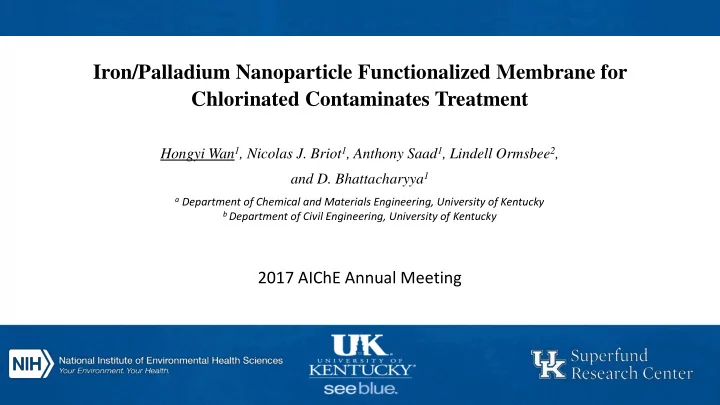

Iron/Palladium Nanoparticle Functionalized Membrane for Chlorinated Contaminates Treatment Hongyi Wan 1 , Nicolas J. Briot 1 , Anthony Saad 1 , Lindell Ormsbee 2 , and D. Bhattacharyya 1 a Department of Chemical and Materials Engineering, University of Kentucky b Department of Civil Engineering, University of Kentucky 2017 AIChE Annual Meeting
PCBs Polychlorinated biphenyls are a group of toxic chemicals, which were largely produced and used as insulating material and lubricants since 1920s. PCBs might be found in electrical equipment and plastic Toxicity Acne-like skin conditions in adults and neurobehavioral and immunological changes in children. PCBs are known to cause cancer in animals (NIH). Have been classified as probably carcinogenic by EPA Current situation PCBs production was banned in US in 1979, was prohibited by 170 countries until 2014 The EPA requires < 0.5 ppb in drinking water. The FDA mandates < 0.2-3 ppm for all food PCBs have been found in at least 500 of the 1,598 current or National Inistitute of Environmental Health Sciences, http://tools.niehs.nih.gov/srp former NPL sites. (Agency for Toxic Substances and Disease California Department of Public Health, Polychlorinated Biphenyl 1988. Urabe, Harukuni, and Masakazu Asahi. Environmental Health Perspectives, 1985. Registry, ATSDR public health statement. Nov 2000) Ogata, Yuko, et al. Marine pollution bulletin 58.10 (2009): 1437-1446. Faroon, Obaid M., et al. Concise international chemical assessment document (2003). Wisconsin Department of Natural Resources, http://ua.dnr.wi.gov. The State Weekly, http://thestateweekly.com/
Common methods: PCBs Incineration, Landfill disposal Treatment Iron/Palladium Nanoparticle Combing catalytic particles with membrane separation Cons: Aggregation and leaching Stability and longevity Recycle and Reuse Meyer and Bhattacharyya. J. Phys. Chem. B, 2007, 111(25), 7142-7154 He F and Zhao D. Applied Catalysis B: Environmental 84 (2008) 533 – 540
Membrane functionalization
Degradation performance Membrane reusability Regeneration Reactivity
Comparisons to other technologies Particle size control, preventing leaching and aggregation, easy to regenerate and reuse Compare to incineration and landfill disposal, it destroys PCBs and control the yield of toxic byproducts This method can be used in heavy metal and other chlorinated organic treatment (TCE). It also shows the potential for functionalizing ceramic membrane polymer brushes Current Ongoing cooperation with nutrition science department for toxicity analysis of degraded products on the macrophages Get access to the contaminated site, take the field samples for further testing Challenges: pre-treatment needed, the longevity of iron nanoparticle, cost and scaling up issues
Acknowledgments Dr. Dibakar Bhattacharyya This research is supported by the NIEHS-SRP at University of Kentucky (P42ES007380)
Recommend
More recommend